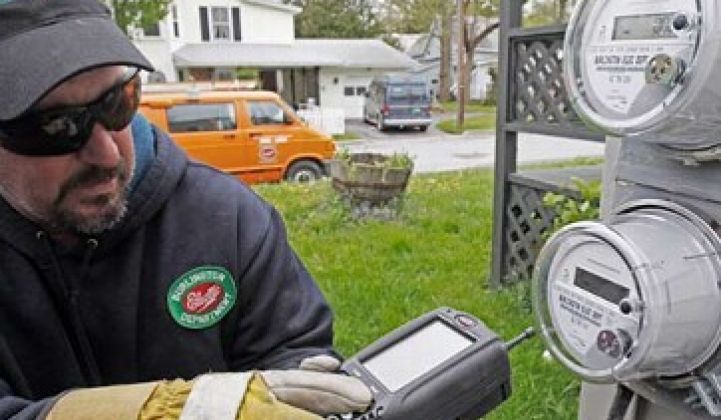Making the business case for advanced metering infrastructure has been tricky business for many utilities, even when they received stimulus funds, as Central Maine Power (CMP) did.
Despite a smart meter deployment to 600,000 customers, which CMP says came within 1 percent of budget, the state’s public utility commission is auditing the utility for runaway project costs. CMP received $96 million from the federal government for smart meters as part of a larger smart grid project, which also includes distribution automation and transmission upgrades.
The costs under scrutiny are operational benefits, such as fewer truck rolls, that will be realized over the next twenty years from the smart meters. In 2010, CMP, owned by Iberdrola USA, projected $25 million in savings over twenty years, but after a more recent calculation, the PUC said it would cost $80 million. CMP is complying with the audit, but noted to the PUC that it has already undergone ten audits since the program began in 2010.
The issue is actually pretty narrow, and does not include environmental or supply-side benefits, such as demand reductions, which are meant to save $338 million over twenty years and are not being debated by the PUC. But the reverberations of getting the cost/benefit wrong has been a public relations nightmare for CMP, which has to find a way to explain long-term benefits to customers while explaining why the technology doesn’t mean rates will drop as soon as it’s installed.
“There’s a lag between when you put the technology in place and when the market -- suppliers and consumers -- comes to it,” said John Carroll, spokesman for CMP. Since 2000, the utility has served only as a distribution company, and Maine is deregulated, so customers are served by energy providers, which will be the ones to leverage the meters for offerings like new rates and demand response programs with nifty thermostats.
The misunderstanding, according to Carroll, is occuring on a few levels. CMP has apparently not seen the PUC’s full calculations and has no idea where the $80 million comes from, but suspects it ignores transmission-related savings in operational costs. The utility thinks it could come from a recently filed revenue requirement figure, which was not meant to be an AMI cost/benefit number.
Like other utilities, CMP is also finding that the benefits from its smart meters can be hard to quantify, such as the cost of fewer angry calls because customers now get fewer estimated bills, which can be inaccurate. Earlier in the process, CMP and the PUC agreed that the rate recovery plan would look at the advanced metering spending separately from other operations.
The problem, however, is that the real value of smart meters is integrating the data, from customer usage to voltage to last-gasp messages, into all aspects of the business. “The power of the data is so integrated into every aspect of our business,” said Carroll, “that we’re not sure we can develop a totally discrete revenue model, especially over twenty years.” Although that issue will not be taken up by the audit, it will eventually have to be settled if there is going to be a realistic rate recovery plan.
“We’re on a steep learning curve,” admitted Carroll. The learning curve extends to how the utility can communicate benefits with customers. It’s not exactly a compelling slogan to simply tell people that it won’t reduce rates in the short term. Utilities across the U.S. struggle to find ways to quantify the myriad of benefits of the new technologies that customers are paying for and then clearly share those benefits with customers in the sort of catchy sound bites that local media outlets can absorb.
So far, CMP has not been able to craft that message, but hopes it will use the audit as a time to get ahead in the conversation. CMP is running into the same problem that other utilities are facing: how do you explain benefits to customers who barely understand how the electrical grid works and generally only spend six minutes a year thinking about their power bill?
Over decades, CMP’s smart grid investment including advanced metering should help keep electricity prices down and give customers more detailed information and control over their energy bills. CMP provides its customers a web portal with detailed energy use information, but most suppliers in Maine have not yet offered differentiated programs that might help customers see the benefit of having the level of granularity that comes from smart meter data.
Just as it’s tough to tell what your favorite app on your smartphone will be one year from now, “It’s amazing to me that people don’t recognize that we can’t project what all the benefits will be five, ten, fifteen years from now because technology is continuously evolving,” said Carroll. A study last year found that not building a smart grid could cost the U.S. $400 billion versus at least $1 trillion in benefits that could be realized if extensive grid modernization is undertaken.
Until recently, utility technology hasn’t evolved at the pace computer technology has evolved in other sectors. But that is changing, and so will the ways that utilities communicate with their customers. “It’s going to change our business in so many ways,” said Carroll, “but if we have a 19th-century technology, there is no upside.”
The audit will be completed in December.



